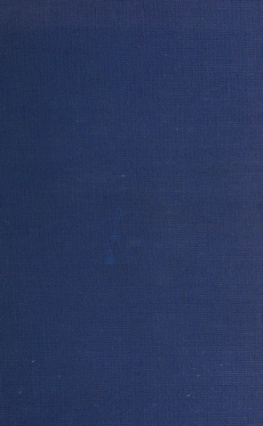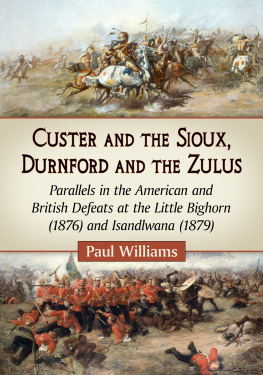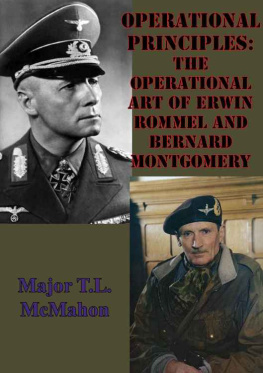
This edition is published by PICKLE PARTNERS PUBLISHINGwww.picklepartnerspublishing.com
To join our mailing list for new titles or for issues with our books picklepublishing@gmail.com
Or on Facebook
Text originally published in 1993 under the same title.
Pickle Partners Publishing 2014, all rights reserved. No part of this publication may be reproduced, stored in a retrieval system or transmitted by any means, electrical, mechanical or otherwise without the written permission of the copyright holder.
Publishers Note
Although in most cases we have retained the Authors original spelling and grammar to authentically reproduce the work of the Author and the original intent of such material, some additional notes and clarifications have been added for the modern readers benefit.
We have also made every effort to include all maps and illustrations of the original edition the limitations of formatting do not allow of including larger maps, we will upload as many of these maps as possible.
OPERATIONAL ART IN THE SIOUX WAR OF 1876
By
MAJ James W. Shufelt, Jr., USA
TABLE OF CONTENTS
Contents
TABLE OF CONTENTS
REQUEST FROM THE PUBLISHER
ABSTRACT
This monograph discusses the role of operational art in the Sioux War of 1876, the U.S. Armys largest campaign between the Civil War and the Spanish-American War. This campaign, often overlooked in the historical study of operational art, demonstrates the successful application of operational art in a non-traditional campaign: the U.S. Armys defeat of the Northern Sioux Indians and their allies. This campaign also demonstrates how operational art can lead to operational victory, despite repeated tactical failures.
The monograph first defines operational art, based on emerging U.S. Army doctrine, and then reviews its role in three campaigns that served as models for the Armys operations in the Sioux War of 1876: Grants 1864-1865 campaign to defeat the Confederacy, the Southern Plains War of 1868-1869, and the Red River War of 1874-1875. The plans and execution of the Sioux War of 1876 are then reviewed and analyzed utilizing the definition of operational art and modem concepts for operational planning. The causes of failure in the 1876 campaign are then analyzed, based on Cohen and Goochs methodology for analysis of military failure, followed by explanation of the campaigns ultimate success.
The monograph concludes that the Frontier Armys success in this campaign demonstrates successful application of operational art, despite many errors in planning and execution committed by General Sheridan and his subordinates. Additional lessons from this campaign include the danger of blindly applying previously successful models for operations, the preeminent role of the operational commander, and the validity of operational art in campaigns against unconventional foes.
Section 1Introduction
While most modem American military officers know of the 25 June 1876 defeat of Lieutenant Colonel George Armstrong Custer and the Seventh Cavalry Regiment at the Little Big Horn River, few would admit familiarity with the origins, conduct, or outcome of the conflict in which the Custer Massacre occurredthe U.S. Armys 1876 campaign to defeat the Northern Sioux Indians. This lack of familiarity with the U.S. Armys largest campaign between the Civil War and the Spanish-American War is regrettable not only for its importance in American westward expansion, but also for the lessons that analysis of this conflict reveals for modem campaign planners. The Sioux War of 1876 is similarly significant for modem students of operational art because of this wars linkage in design and leadership to General Ulysses S. Grants successful 1864-1865 campaign against the Confederacy.
Considered by some modem historians as the first American example of operational art, Grants campaign against the Confederacy was the model in design and spirit for two successful post-Civil War military campaigns against the Plains Indians: the Southern Plains War of 1868-1869 and the Red River War of 1874-1875. Despite these successes, the Armys 1876 campaign against the Sioux was initially disastrous, highlighted by defeats at the Powder River, Rosebud Creek, and the Little Big Horn River. Recovering from these setbacks, the Army eventually succeeded in its campaign against the Sioux, driving the Indians back to government reservations by the Spring of 1877.
Simple explanation of the Armys initial failure and ultimate victory in 1876 is confused by a century of emotional debates, personal defenses by key participants, and public focus on the Custer Massacre. Explanation of final success is similarly difficult while the Armys ultimate victory in this operation was not caused by the conscious application of the modern concept of operational art, aspects of this concept were present in the Armys operations against the Indians. However, the initial failure of a campaign so closely linked with Grants seminal campaign demonstrates limitations in the modem concepts of operational art and campaign plan design and execution. The resulting research question utilized in this study is: did the United States Armys 1876 campaign against the Sioux and Cheyenne Indians demonstrate successful application of operational art?
To answer the research question, Section Two of this study explains modern concepts of operational art and campaign planning, based on current and emerging military doctrine. Section Two also reviews Grants 1864-1865 campaign against the Confederacy, highlighting the role of operational art. Section Three reviews the 1876 campaigns post-Civil War antecedents: the Southern Plains War of 1868-1869 and the Red River War of 1874-1875. This discussion is followed by review of the U.S. Armys 1876 campaign against the Sioux Indians and their allies. Section Four analyzes the Armys initial failure in 1876, utilizing the methodology for analysis of military failure presented in Eliot A. Cohen and John Goochs Military Misfortune. {1} {2} Section Four concludes with an explanation of the ultimate success of the 1876 campaign. Section Five analyses the 1876 campaign utilizing the definition of operational art and planning fundamentals from FM 100-5. Operations. {3} The study ends with Section Six, conclusions and recommendations.
Section 2The origins of Operational Art
Operational art is a doctrinal construct that embraces the purpose, organization, and structure of military campaigns. Over the last decade, this concept has become a cornerstone of U.S. Army doctrine. The 1993 final draft version of FM 100-5, the U.S. Armys primary doctrinal manual, defines this concept as the employment of military forces to attain strategic goals in a theater of war or theater of operations through the design, organization, and execution of campaigns and major operations. {4}
Operational art is not an automatic component of military operations; it must be appropriate, consciously developed, and properly implemented. To assist in explanation of this concept, FM 100-5 provides requirements for its successful application: broad vision, anticipation, an understanding of ends to means, and effective joint and combined cooperation. {5} Successful actualization of operational art demands commanders who see beyond individual battles and visualize the conduct of military operations distributed in time and space. Another component is the commanders ability to anticipate the result of tactical engagements and likely enemy responses and implement or adjust his plan of operations accordingly. The most significant component of operational art is the commanders comprehension of the linkage between ends to meansthe relationship between campaign objectives and available military forces and actions.







